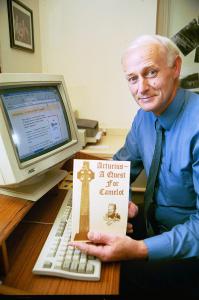Historian claims to have solved King Arthur mystery
£50,000 to anyone who can prove him wrong
There is no doubt in my mind that Arturius is the real King Arthur.”
HULL, EAST RIDING OF YORKSHIRE, UNITED KINGDOM, July 2, 2018 /EINPresswire.com/ -- Historian claims to have solved King Arthur mystery with 1300-year-old Swiss manuscript— David F Carroll
A historian believes he has found proof that the legendary King Arthur was actually the son of a 6th century Scottish king – and is offering £50,000 to anyone who can prove him wrong.
David Carroll, has spent more than twenty- five years researching the legend of King Arthur, a quest that has taken him all over Europe delving into ancient manuscripts and records.
After finding a manuscript hidden away under lock and key in the town library of Schaffhausen in Switzerland, the historian believes he has irrefutable proof that a sixth-century Scottish prince is the true source of the Arthurian legend.
The Dorbene manuscript, written by 7th century monks, is the oldest historical document in the world to mention Arthur.
David says the similarities between the Scottish battle leader Arthur documented in the manuscript and the legend of King Arthur cannot be ignored.
The story of David’s Arthur, or Arturius as he was referred to by the monks, is almost identical to that of the legendary king we all know today.
Arturius was the son of a 6th century Scottish king called Aiden.
David said:
“There is no doubt in my mind that Arturius is the real King Arthur.
Both were active in the 6th century, both died in battles against the Picts, both were Christian, both fought alongside Urien and other British kings and both had a sister called Morgan – a name unheard of in 6th and 7th century records.
To have a brother and a sister at that time called Arthur and Morgan is highly unlikely. It would be like finding another Napoleon and Josephine or Antony and Cleopatra – it’s almost impossible.”
Arturius’ documentation in the manuscript came five centuries before Geoffrey of Monmouth introduced the story of Arthur into Cornish legend.
The distribution of the manuscript throughout Europe would explain why Arthur was known in mainland Europe centuries before being connected to Cornwall in the 12th century.
David believes the reason why, for centuries, this 6th century prince was overlooked as being the source of Arthurian legend is because he was referred to as a battle leader by the monks, not as a king.
David said:
“Arturius was referred to as a battle leader, never a king, but he was the son of a king. Had he not died in battle against the Picts, he could have eventually succeeded his father and become King Arturius – King Arthur.”
To add to David’s claims, most research into Arthurian legend dates back as far as a 9th century Welsh monk, Nennius, who also refers to Arthur as a battle leader – as per the Swiss manuscript written two centuries earlier.
David has written a book based on his research called ‘Arturius – A Quest for Camelot’ which is now available to download for free at:
http://www.electricscotland.com/history/arturius.htm
Ends
For more information or media enquiries you can contact David at:
Email – dfcarroll@yahoo.com
Telephone number - +44(0)1482 842257
Notes to editors:
Dorbene Manuscript
The Dorbene manuscript or ‘Vita Columba’ was written by monks in the 7th century on the remote island of Iona, the birthplace of Christianity in northern Britain. It was then copied and transported to monasteries throughout Europe. The earliest known copy in Europe was made at the monastery of St.Gall in Switzerland, around the year 850 A.D. Today the original copy from Iona can be found under lock and key in the town library of Schaffhausen, Switzerland.
Arturius – A Quest for Camelot
David is keen to hear from anyone who thinks they can prove that King Arthur is based on someone other than the 6th century Scottish prince Arturius.
Like Arturius and the legendary King Arthur, they must have:
• been active in the 6th century
• had a sister called Morgan
• died in battle against the Picts
• been a Christian
• fought alongside Urien and other British kings.
David F Carroll
David Carroll Inc
01482 842257
email us here

